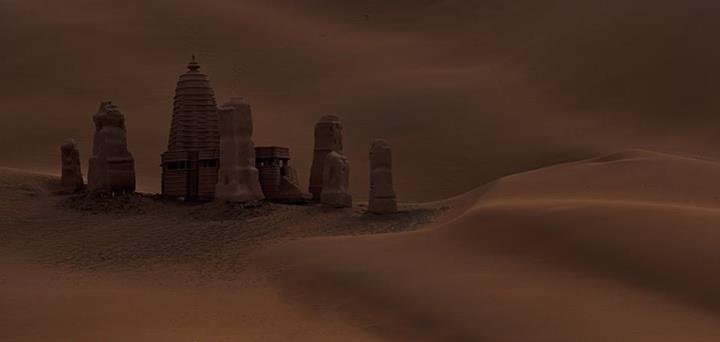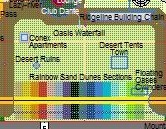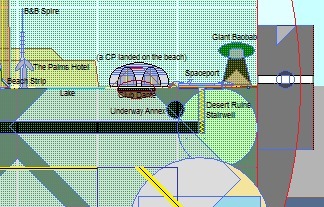
Desert Ruins News: These ruins, once just a handful of small objects, now include thousands.
aaaaaaaa
Desert Ruins
Desert Ruins
Note:
Note:
Inisfreeans maintain a number of constructs designed to have the convincing appearance of being the ancient and partially eroded remains of once great towns, outposts, and holy sites (another example of this are the city's Indian-architecture-themed ruins nestled atop the Dragon's-back Mountains ridge, and then there is the Basket-bells Ruins which are themed after Borobudur, a Mahayana Buddhist Temple in Magelang, Indonesia). The idea is in part one of aesthetics, and is to provide serene, quiet getaways for those seeking some time alone and miles away from the other Inisfreeans and their guests. These faux ruins sites are also used for various training purposes ranging from archaeological digs and sensitive site exploitation (a form of intelligence gathering) to dynamic entries.
Local Specifics:
This particular ruins site is a complex of buildings and other structures covering a land area of roughly 330'x330'; ground-level floorspace exceeding 108,000 square feet, with more when counting that of the floors, balconies, and rooftops above, and the basements, faux tombs, and other rooms below. (To give you a better idea of the expanse of these ruins, they cover an area comparable to 1.5 to 2 professional-size soccer fields.) On the surface, amidst mingling and slowly creeping sand dunes a dozen feet tall or more, are more than a dozen major buildings, most of which are complemented by smaller constructs such as the variety of obelisks, pagodas, stone pavilions of the gazebo type, and stand-alone columns; pillars, usually 'bulging' cylindrical ones, each artistically crafted to look the eroded, sand-blasted remnants of temples once massive enough to house Titans. In total, there are more than one thousand distinct components to this complex of faux ruins; the 13 largest buildings (which have the most floors and rooms above and below the sandy surface) along with the 47 chapel-sized ones and the hundreds of obelisks and other supplemental building blocks scattered about them all. Most of them are colored to blend in with the surrounding, earth-tones sand; an almost clay-like brown of a burnt umber appearance very similar to the average Brazilian's or Peruvian's complexion. Seeing these ruins from a distance (and distinguishing them from the immediately adjacent terrain and landmarks) is only possible for Inisfreeans and their guests with eagle-level eyesight and beyond.
Secret:
Hidden somewhere amongst these half sand covered ruins... is an All-in-one-well (AIOW), the largest of its kind in all of Inisfree. Its vertical shaft extends over half a mile straight down into the bedrock of the city, far below the local desert's sand dunes, some of which are hundreds of feet tall. Near the bottom of this AIOW the walls open out in all directions to reveal the main perambulatory access point for the narrow-end of the Underway (Inisfree's term for the opposite of a highway; for the underground major transit artery that connects hundreds of Inisfree's largest civilian-access caves and their many attractions). The total depth this AIOW reaches is three fifths of a mile. Unlike most of Inisfree's AIOWs which are the size of a standard stairwell for a major office building, stadium, or parking garage, this AIOW has a diameter of more than 450 feet (picture a 45-story skyscraper resting on its side). That's large enough to fly a helicopter squadron down into and back up out of with ease, so once you find this cavernous Inisfreean version of a stairwell, be prepared to be awestruck and, perhaps, subject to a wave of the fear-of-heights sensation and shaky knees.
Local Specifics:
This particular ruins site is a complex of buildings and other structures covering a land area of roughly 330'x330'; ground-level floorspace exceeding 108,000 square feet, with more when counting that of the floors, balconies, and rooftops above, and the basements, faux tombs, and other rooms below. (To give you a better idea of the expanse of these ruins, they cover an area comparable to 1.5 to 2 professional-size soccer fields.) On the surface, amidst mingling and slowly creeping sand dunes a dozen feet tall or more, are more than a dozen major buildings, most of which are complemented by smaller constructs such as the variety of obelisks, pagodas, stone pavilions of the gazebo type, and stand-alone columns; pillars, usually 'bulging' cylindrical ones, each artistically crafted to look the eroded, sand-blasted remnants of temples once massive enough to house Titans. In total, there are more than one thousand distinct components to this complex of faux ruins; the 13 largest buildings (which have the most floors and rooms above and below the sandy surface) along with the 47 chapel-sized ones and the hundreds of obelisks and other supplemental building blocks scattered about them all. Most of them are colored to blend in with the surrounding, earth-tones sand; an almost clay-like brown of a burnt umber appearance very similar to the average Brazilian's or Peruvian's complexion. Seeing these ruins from a distance (and distinguishing them from the immediately adjacent terrain and landmarks) is only possible for Inisfreeans and their guests with eagle-level eyesight and beyond.
Secret:
Hidden somewhere amongst these half sand covered ruins... is an All-in-one-well (AIOW), the largest of its kind in all of Inisfree. Its vertical shaft extends over half a mile straight down into the bedrock of the city, far below the local desert's sand dunes, some of which are hundreds of feet tall. Near the bottom of this AIOW the walls open out in all directions to reveal the main perambulatory access point for the narrow-end of the Underway (Inisfree's term for the opposite of a highway; for the underground major transit artery that connects hundreds of Inisfree's largest civilian-access caves and their many attractions). The total depth this AIOW reaches is three fifths of a mile. Unlike most of Inisfree's AIOWs which are the size of a standard stairwell for a major office building, stadium, or parking garage, this AIOW has a diameter of more than 450 feet (picture a 45-story skyscraper resting on its side). That's large enough to fly a helicopter squadron down into and back up out of with ease, so once you find this cavernous Inisfreean version of a stairwell, be prepared to be awestruck and, perhaps, subject to a wave of the fear-of-heights sensation and shaky knees.
沙漠
廢墟




